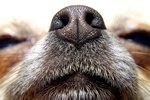If a dog has a destructive chewing habit, it is up to the owner to determine the underlying cause for her chewing and what steps to take to solve the issue. If you're at your wits end, you may be tempted to use a muzzle, but be warned that this will only resolve the chewing problem on a short term basis. Actual training will be required in order to resolve chewing problems effectively and permanently.
The Good News
A muzzle is a deterrent that keeps your dog from being able to take any solid object into his mouth. A muzzle will also prevent a dog from chewing when left alone in the car or in other similar short-term situations during which chewing could be a problem.
Muzzles are deterrents to chewing, but they are also excellent training aids. Sometimes figuring out the reason your dog chews takes time—time during which valuable possessions are being destroyed. A muzzle does not correct any problems on its own, but if used humanely, can be a useful tool to keep your dog from chewing while you figure out the potential causes for the chewing behavior.
The Bad News
Chewing is never done for chewing’s sake. Whenever a dog chews, it is to make himself feel better. A muzzle will only remove the dog’s ability to chew. It will not reduce the desire to do so.
Consult a veterinarian to determine if your dog has any physical issue that might be causing him to chew. Dogs also chew from boredom or out of anxiety, so the dog’s environment should be examined. If the environment does not provide entertainment or diversion for the dog it is important to add interactive toys or acceptable items for your dog to chew during the day. If your dog’s environment creates stress, stressors should be reduced or removed to reduce chewing. Although a muzzle can control chewing while you determine its cause, training the dog not to chew should be the ultimate goal.
Problems with Using Muzzles to Prevent Chewing
Given enough time, your dog can escape from most muzzles. Cloth muzzles and soft-sided leather muzzles may buckle at the sides, allowing the dog to remove his mouth from inside. In addition, cloth muzzles do not allow the dog to open his mouth at all, and therefore prevent him from eating, drinking and panting. These two factors are significant reasons not to use muzzles as a sole measure to control chewing.
Alternatives to Using Muzzles for Chewing
Supervise your dog and interact with him to prevent chewing. In addition, giving your dog his own things to chew while crated is a positive step toward changing his behavior. Your dog should never be forced to stay crated for long periods simply to prevent chewing; however, if your dog chews while you are at work or while you are gone for other times during the day, training him to stay quietly in his crate will help prevent him from damaging your items. If your dog is not going to be crated while you are gone, make certain your home is dog-proofed, with all forbidden chewable items out of reach. Alternatively, confine your dog to one room using a baby gate, dog-proof the room, and provide your dog with interactive toys to entertain himself with.
By Jo Chester
References
VetInfo: Using a Dog Muzzle to Stop Chewing
WebMD: Healthy Dogs: Destructive Chewing in Dogs
Cesar’s Way: 5 Steps to Correct Inappropriate Dog Chewing
About the Author
Jo Chester holds a certificate in pet dog training from Triple Crown Academy for Dog Trainers. She has trained dogs for competition in conformation, Rally and traditional obedience and agility. Chester has two goats, chickens, rabbits, a collie and a pet rat, in addition to several much-loved Toy Fox Terriers.
Writer Bio
This article was written by the CareerTrend team, copy edited and fact checked through a multi-point auditing system, in efforts to ensure our readers only receive the best information. To submit your questions or ideas, or to simply learn more about CareerTrend, contact us [here](http://careertrend.com/about-us).





